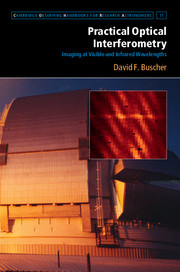Book contents
- Frontmatter
- Contents
- Principal symbols, functions and operators
- List of abbreviations
- Foreword
- Preface
- 1 Making fringes
- 2 Basic imaging
- 3 Atmospheric seeing and its amelioration
- 4 Interferometers in practice
- 5 Measurement noise
- 6 Interferometric observation of faint objects
- 7 Observation planning
- 8 Data reduction
- 9 Model fitting and image reconstruction
- Appendix A Fourier transforms
- Appendix B Supplementary online material
- References
- Index
4 - Interferometers in practice
Published online by Cambridge University Press: 05 August 2015
- Frontmatter
- Contents
- Principal symbols, functions and operators
- List of abbreviations
- Foreword
- Preface
- 1 Making fringes
- 2 Basic imaging
- 3 Atmospheric seeing and its amelioration
- 4 Interferometers in practice
- 5 Measurement noise
- 6 Interferometric observation of faint objects
- 7 Observation planning
- 8 Data reduction
- 9 Model fitting and image reconstruction
- Appendix A Fourier transforms
- Appendix B Supplementary online material
- References
- Index
Summary
Previous chapters have assumed a rather generalised and abstract interferometer. This chapter looks at the how the functionality of this abstract interferometer is implemented in reality. This exposition will make use of examples from existing interferometers, with the aim of giving an idea of the diversity and ingenuity of the implementations of this functionality.
Interferometric facilities
The following is a brief summary of the interferometric facilities which were operational at the time of writing or expected to be operational within the next few years. The systems are listed in order of the date (or expected date) of ‘first fringes’ on each of these interferometers. More information can be found in the online supplementary material (see Appendix B).
Aperture-masking instruments Masking the aperture of a single telescope to convert it into an interferometer was used in the very earliest days of interferometry, and yet it is still a competitive technique for many astronomical measurements (Tuthill, 2012). Because the implementation challenges for aperture masking are in some ways different to those for separated-element interferometry, discussion of the practical features of this technique is deferred until Section 4.10.
SUSI The Sydney University Stellar Interferometer (Davis et al., 1999) is sited near to the radio telescopes of the Australia Array in Narrabri, Australia. It operates at visible wavelengths and has baselines ranging from 5m to 640m (currently only baselines up to 80m have been commissioned).
NPOI The Navy Precision Optical Interferometer (formerly the Navy Prototype Optical Interferometer) (Armstrong et al., 1998) is sited on the Lowell Observatory Anderson Mesa Station in Arizona, USA. It operates at visible wavelengths and is capable of performing wide-angle astrometric measurements as well as interferometric imaging. It has baselines from 2m to 437m (at the time of writing only baselines from 8.8m to 79m have been commissioned).
- Type
- Chapter
- Information
- Practical Optical InterferometryImaging at Visible and Infrared Wavelengths, pp. 91 - 128Publisher: Cambridge University PressPrint publication year: 2015



